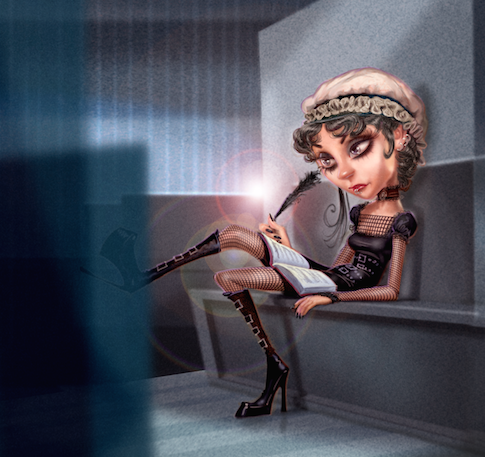There are many, many deaths in this medium-sized volume. An obliging debutante who has agreed to marry two men jumps in a river. A widow cheers up a young companion with the story of how she lost her husband, her children, and her father in the space of a few weeks. Two women are transfixed by the sight of a carriage rolling over, only to see their husbands emerge from it "most elegantly attired but weltering in their blood."
Most of these pieces—novelettes, plays, poems, essays, letters to and from imaginary persons—are drawn from a series of notebooks into which Jane Austen made fair copies of things she had written between the ages of 11 and 18. (In a spirit of mock solemnity, she labeled the notebooks "Volume the First," "Volume the Second," and "Volume the Third.") They were not put down in the order of their composition, nor is it easy to detect any kind of thematic arrangement. Austen transcribed them at her leisure into whichever of the three notebooks she had in front of her, which gives the present collection the enjoyable character of a scrapbook. Frequently atrocious spelling ("Love and Freindship," "neice," "Toothake") and a laissez-faire approach to punctuation heighten this effect.
The occasionally shocking subject matter notwithstanding, virtually everything here seems to have been written for the purpose of provoking laughter, and nearly all of it does. Because most of these short pieces are prefaced with dedications, we often have a very good idea of whom she was hoping to amuse: "To the Revd George Austen. Sir, I humbly submit your Patronage to the following Comedy which, tho’ an unfinished one is, I flatter myself as complete a Mystery as any of its kind." Her delight in this sort of thing is apparent and, at times, overwhelming:
COUSIN
Conscious of the Charming Character which in every Country, & every Clime in Christendom is Cried Concerning you, with Caution & Care I Commend to your Charitable Criticism this Clever Collection of Curious Comments, which have been Carefully Culled, Collected, & Classed by your Comical Cousin
The Author
Like most writing by clever young people, Austen’s juvenilia shows us not merely what she read but also what she remembered and enjoyed. It is clear from the echoes and allusions here that one could get on very well in those days reading nothing but Shakespeare, Richardson, Fielding, Dr. Johnson, Goldsmith, minor epistolary and Gothic novels, and the reprinted sermons of a few forgotten bishops. Her History of England, from the reign of Henry the 4th to the death of Charles the 1st, by a partial, prejudiced, and ignorant Historian shows how much fun she had powering through Hume’s six fat volumes ("Though this King had some faults, among which and as the most principal, was his allowing his Mother's death, yet considered on the whole I cannot help liking him").
There is an element of exuberance in this youthful prose that is missing in the perfectly cadenced, Gibbon-in-a-minor-key sort of sentences that Austen was later to produce. It is nice, too, to have in the person of the title character in Lady Susan a protagonist whom we do not feel compelled to identify with or even admire. In fact, the young Austen makes me think of Evelyn Waugh, whose horse-trampled young squires and cannibalized fiancées would be very much at home here with the babies biting off their mothers’ fingers and the teenagers stealing small fortunes and running away to join the theater. For a moment it becomes possible to imagine, say, Mansfield Park as a very different sort of novel, one in which Fanny is a naïve hypochondriac and the Miss Bertrams get everything they want simply by asking for it.
But then one comes across a paragraph or even a sentence such as this one: "Not being able to resolve to make any one miserable, she consented to become his wife; whereupon the Gentleman left the room and all was quiet." Here, faintly but unmistakably, is that characteristic note of quiet empathy; the raucous irony has been sublimated into something a bit more decorous but no less amusing, and she begins to resemble the author of her mature novels. We hit astonished, indeed open-mouthed, upon the truth, namely that the teenaged Austen was already a prudent, wise, humble person trying to make sense of a world full of boorishness and stupidity.
Most of this material has long been available, though until now never with Lady Susan, which is usually paired with The Watsons but belongs properly to this volume's period. A glance at the shoe pattern on the cover—to say nothing of the crimson endpapers and the grey ribbon marker—suggests that Penguin has issued Love and Freindship and Other Youthful Writings with the Janeites in mind. Many sneer at these dedicated, mostly female readers who apply their own version of the higher criticism to the novels and enjoy checking the BBC adaptation against their detailed maps of Pemberley. This is the worst sort of snobbery. With the possible exception of Shakespeare, no other major English writer has inspired such devotion outside the academy, a rare example of popular taste getting things exactly right.
I am, as it happens, something of a male Janeite myself, and thus glad to put this book on the shelf beside my Cambridge Austens. Had she written nothing but these early squibs, the author of "Frederic and Elfrida" might be remembered by a few scholars as a kind of eccentric girl genius—the Stevie Smith of 18th-century fiction. Instead, we have the extraordinary pleasure of seeing the greatest novelist in our language goofing off.
